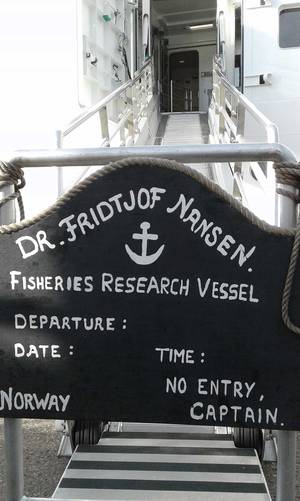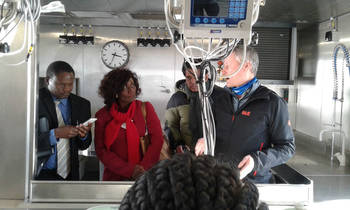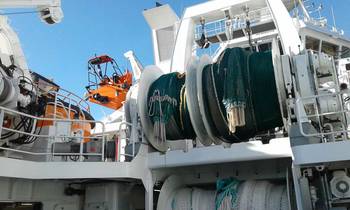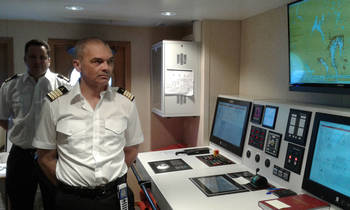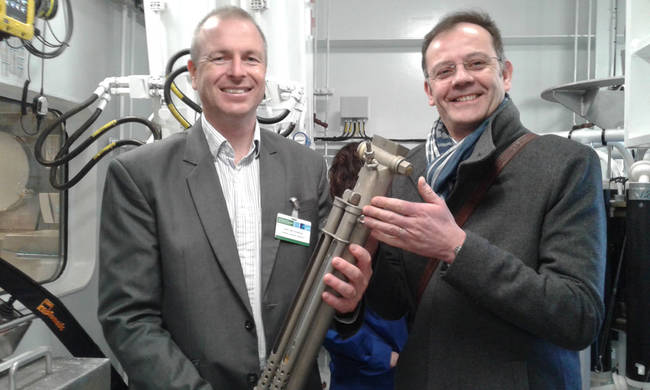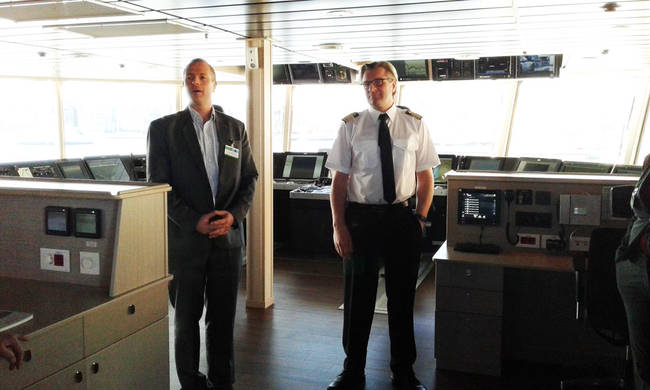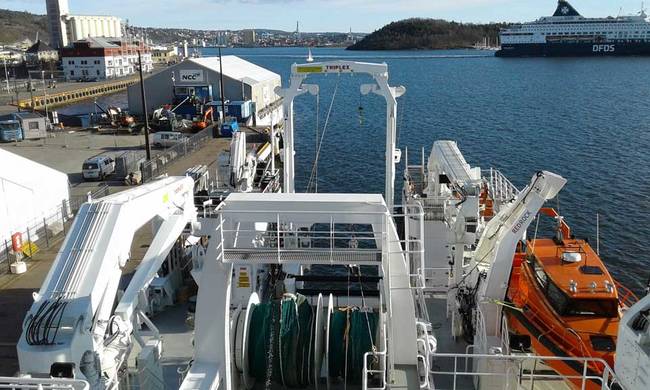Climb aboard. We’re expecting you! #EAFNansen
Thursday in Oslo was dedicated to an interesting Ocean Conference exploring many areas of research of the new Nansen vessel, and bringing colleagues from Africa to speak about their experiences as countries in which Nansen surveys took place.
A day before the official Naming Ceremony, those of us who were conference participants were provided a sneak peek of the vessel – even more impressive under bright blue skies and blazing sunshine rather unusual for March in Norway.
Visitors explored the state-of-the-art vessel and the experienced Norwegian Institute of Marine Research (IMR) crew – most of whom served aboard the previous Nansen – were on hand to explain the technology on board and to answer questions.
The Nansen’s chief engineer was involved in all aspects of the ship’s construction in the Vigo, Spain shipyards. “This vessel was designed with two priorities in mind: to be extremely fuel efficient and to reduce to a minimum the amount of noise. The latter is especially important for a vessel such as this where so much research is taking place.
The motor of the new Nansen produces heat that we need on board and it is also optimized to produce fresh water for use of the scientists and crew on board. We can produce up to 25 000 litres of fresh water a day from sea water. We also have environmentally friendly features, including a sewage waste system similar to those on land.”
In the ship’s science hangar, IMR experts explained to us how the CTD (Conductivity, Temperature and Depth) equipment was deployed to take sharp video images deep below the ocean’s surface. New Manta trawls can go beyond the normal trawls for microplastics along the ocean’s surface.
These Manta trawls can also collect samples at various depths along the water column. “And,” according to an IMR technician, “this hangar space doubles as a repair shop, because, as you know, electronics and saltwater don’t always get along.”
All data obtained on board is entered into a dedicated database, the NANSIS. The ship boasts a new climate lab, which is expected to see much research on its next survey trips.
The Nansen chef welcomes us into the mess hall, with its attractive, light Scandinavian design it clearly needs a new name.
He, too, worked on the past Nansen vessel and is used to ordering provisions for 1-2 months for three meals a day. Throw in an international team with differing dietary needs, and shifts around the clock, and it becomes clear this is no small task.
We visited the nerve center of the ship – where all the computers are housed.
Those computers gather all the data from the ship, a staggering 1-2 terrabytes every 24 hours.
“As you can imagine,” says Asa, and IMR scientist, “storing all of this data is a challenge we face on board this vessel. Once or twice a day we sit down to scrutinize all this data.”
Captain Stephenson – who also served on the old Nansen - showed us around the impressive deck, with its latest Norwegian technology. “All this equipment is integrated,” according to the Captain. “
This means it’s easier for us when we carry out multiple procedures. The new layout of the deck also provides us with a full view of the trawls and use of CTD and other equipment.”
A ship like the Nansen, conducting research in waters off the coast of Africa also has special needs.
According to Captain Stephenson, “In African waters, many ships are not made of steel, but are simple wooden canoes.
A ship of this size would have a hard time spotting them in the night, so we have special infrared cameras installed that can sense these vessels up to 1000 meters away, thereby avoiding collisions in the dark.
We also have an extremely high resolution camera that can zoom in up to 3000 meters.”
Those of us on board saw this experiment first-hand, zooming in to see Oslo’s ski jump up close, even if it was only a tiny speck with the naked eye from the Oslo harbour.
We also learned that a vessel like this is a bit like an airplane. It contains a black box in the deck, very similar to that found it a cockpit of an airplane.
With its impressive laboratories, airy shared spaces and clean, new design, the Nansen will be a worthy vessel for its upcoming survey voyages along Africa’s western coast. As always, we’ll be joining along on those trips via this #EAFNansen blog, in order to bring the work on board to life for armchair marine biologists.
A long and happy life to the new Nansen, which will be officially christened in Oslo’s harbor 24 March. Onward to new adventures!


